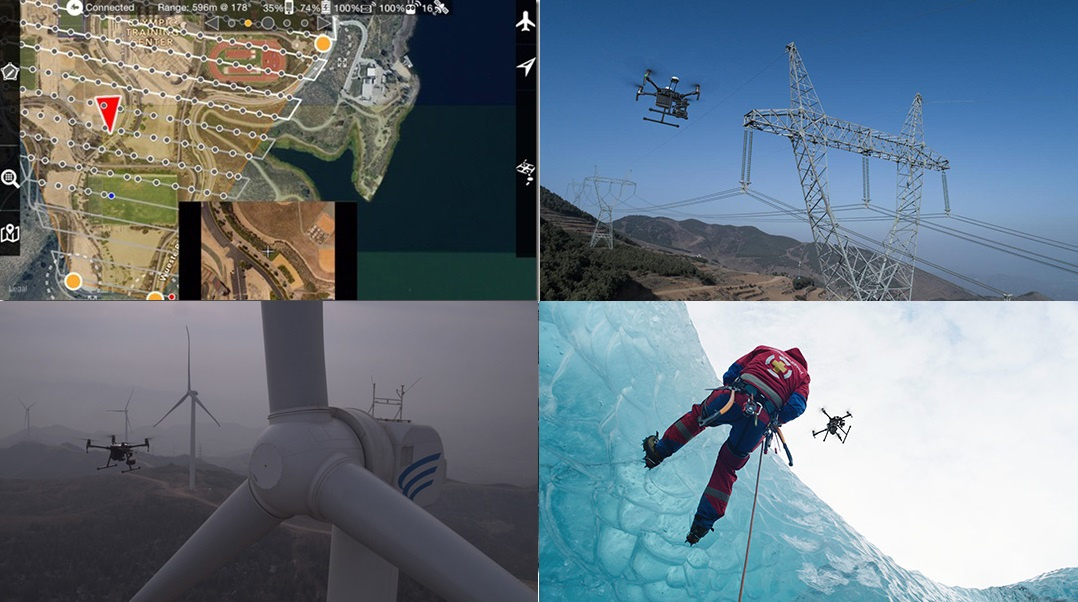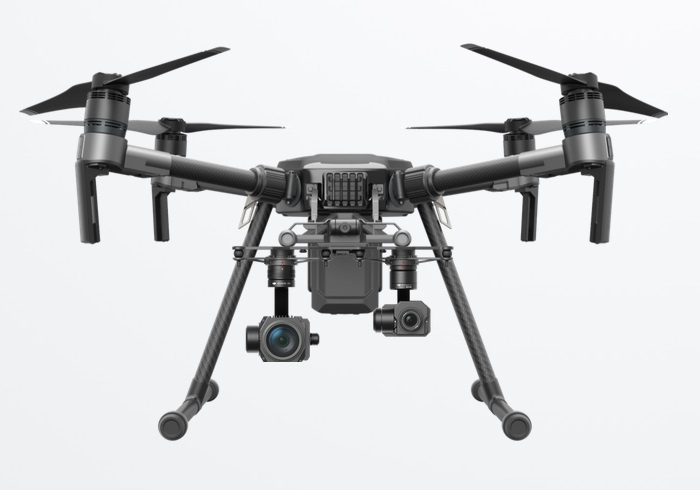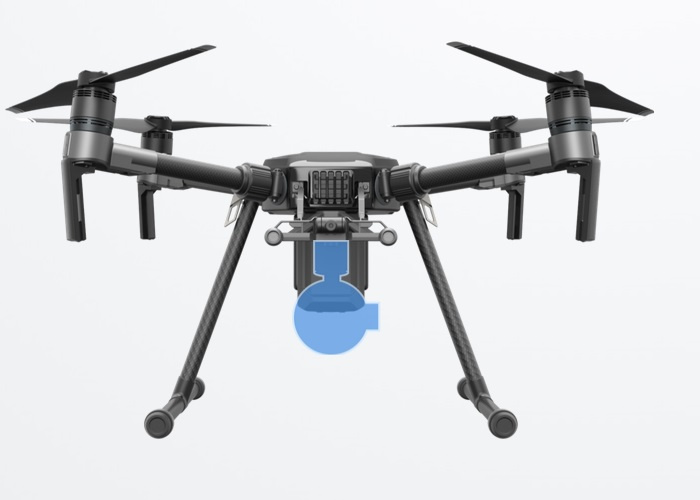Review of a series of industrial quadrocopters DJI Matrice 200/210 / RTK
“Fly where wolves are afraid to sleep.”
Briefly about the DJI Matrice 200 series:
')

The main feature of the 200 series is a closed case, you can put your own load on the 210, RTK allows you to achieve centimeter positioning accuracy and fly in the field of the electromagnetic field of power lines.




The M200 series is equipped with a FlightAutonomy system consisting of 7 sensors. The front sensors of the viewing system detect obstacles 30 meters in front of the drone, and upper infrared sensors detect objects 5 meters above the aircraft. Lower optical sensors provide precise positioning in the air and a safe landing.
In addition to all this, the ADS-B receiver was installed on the drone for the first time.

Ingress Protection Rating (translated from English - the degree of protection against penetration) is a system for classifying the degrees of protection of electrical equipment and other devices against penetration of solid objects, dust and water in accordance with the international standard IEC 60529 (DIN 40050, GOST 14254). [ Wikipedia ]
The first digit - protection from the penetration of foreign objects:

The second number is protection against water penetration:


Only the lower gimbal is supported, but a wide choice of camera options:


It supports various camera installation options - double, top and third-party equipment.

Double bottom.

Upper.

Third party equipment.

Equipped with centimeter accuracy positioning system.

Options for suspensions and cameras, the same as in 210.

RTK is a high-precision positioning and navigation system supporting a receiver operating on four frequency channels and two satellite communication channels: GPS + BDS and GPS + GLONASS. The system guarantees centimeter positioning accuracy in both horizontal and vertical planes.
RTK is much more accurate than conventional navigation devices, such as a barometer, compass, and GPS-based instruments. This makes this system an indispensable tool in industry, science and other areas where measurement accuracy is important.
HEIGHT ACCURACY
Most unmanned aerial vehicles use barometers to measure altitude. These instruments often produce distorted data due to exposure to air waves during takeoff, braking and during long flights. This, in turn, causes system crashes. Thanks to RTK, specialists get coordinates, the accuracy of which lies within centimeter limits.
TWO ANTENNA FOR HIGH ACCURACY
Two antennas guarantee more accurate heading information than a compass. The absence of a compass increases the noise immunity of the system, allowing the aircraft to function normally even under electromagnetic interference near power lines and metal structures.
Are common
Positioning accuracy
Horizontal: 1 cm + 1 millionth
Vertical: 2 cm + 1 millionth
Orientation accuracy
(0.3 / R) °
R is the base distance, the distance between the two antennas of the air system in meters.
RMS (RMS)
0.03 m / s
Frequency used
Global version: GPS L1 & L2, GLONASS F1 & F2
Asia Pacific: GPS L1 & L2, BEIDOU B1 & B2
Interface
CAN, UART, USB
Input voltage
3S ~ 12S (12 ~ 52 V)
power usage
5.2 W
Current
0.45 A (at 12 V)
D-RTK processor dimensions
112.3 × 63 × 18.6 mm
D-RTK processor weight
139.5 g
Operating temperature range
0 ... + 45 ° C
Storage temperature range
-40 ... + 85 ° C
Read more about RTK here .
Briefly about the DJI Matrice 200 series:
')
- The main difference from other series is the enclosed housing design = resistance to rain / snow, degree of protection IP43
- payload of 2 kg, you can install your gadgets
- 17-inch propellers = stable flight even with strong winds up to 7 km
- two batteries with a self-heating system that allows you to fly in a frost = 38 minutes of flight

The main feature of the 200 series is a closed case, you can put your own load on the 210, RTK allows you to achieve centimeter positioning accuracy and fly in the field of the electromagnetic field of power lines.
General information about the DJI Matrice 200/210 / RTK series

Application

- Create a map of the land.
- Checking high-voltage power lines and other vertical structures such as wind turbines or drilling platforms.
- Verification of key infrastructure facilities.
- Search and rescue operations and emergency assistance.

- Vegetation monitoring.
- Check the solar panels.
- Fire fighting.
- Check TV tower.
- Building accurate 3D models in construction.
- Remote survey of oil platforms.
Collision avoidance

The M200 series is equipped with a FlightAutonomy system consisting of 7 sensors. The front sensors of the viewing system detect obstacles 30 meters in front of the drone, and upper infrared sensors detect objects 5 meters above the aircraft. Lower optical sensors provide precise positioning in the air and a safe landing.
In addition to all this, the ADS-B receiver was installed on the drone for the first time.
"AZN-V (born Automatic dependent surveillance-broadcast), AZN-V (automatic dependent surveillance-broadcasting) is a technology that allows pilots in the cockpit and air traffic controllers to monitor the movement of aircraft with greater accuracy than it was previously available, and receive aeronautical information; currently being introduced in the USA, Russia and other countries. „
- Wikipedia
Degrees of protection - IP (degree of protection of the shell)

Ingress Protection Rating (translated from English - the degree of protection against penetration) is a system for classifying the degrees of protection of electrical equipment and other devices against penetration of solid objects, dust and water in accordance with the international standard IEC 60529 (DIN 40050, GOST 14254). [ Wikipedia ]
The first digit - protection from the penetration of foreign objects:

The second number is protection against water penetration:

Payload
Matrice 200

Only the lower gimbal is supported, but a wide choice of camera options:


Matrice 210
It supports various camera installation options - double, top and third-party equipment.

Double bottom.

Upper.

Third party equipment.
Matrice 210 RTK

Equipped with centimeter accuracy positioning system.

Options for suspensions and cameras, the same as in 210.
RTK

RTK is a high-precision positioning and navigation system supporting a receiver operating on four frequency channels and two satellite communication channels: GPS + BDS and GPS + GLONASS. The system guarantees centimeter positioning accuracy in both horizontal and vertical planes.
RTK is much more accurate than conventional navigation devices, such as a barometer, compass, and GPS-based instruments. This makes this system an indispensable tool in industry, science and other areas where measurement accuracy is important.
HEIGHT ACCURACY
Most unmanned aerial vehicles use barometers to measure altitude. These instruments often produce distorted data due to exposure to air waves during takeoff, braking and during long flights. This, in turn, causes system crashes. Thanks to RTK, specialists get coordinates, the accuracy of which lies within centimeter limits.
TWO ANTENNA FOR HIGH ACCURACY
Two antennas guarantee more accurate heading information than a compass. The absence of a compass increases the noise immunity of the system, allowing the aircraft to function normally even under electromagnetic interference near power lines and metal structures.
Are common
Positioning accuracy
Horizontal: 1 cm + 1 millionth
Vertical: 2 cm + 1 millionth
Orientation accuracy
(0.3 / R) °
R is the base distance, the distance between the two antennas of the air system in meters.
RMS (RMS)
0.03 m / s
Frequency used
Global version: GPS L1 & L2, GLONASS F1 & F2
Asia Pacific: GPS L1 & L2, BEIDOU B1 & B2
Interface
CAN, UART, USB
Input voltage
3S ~ 12S (12 ~ 52 V)
power usage
5.2 W
Current
0.45 A (at 12 V)
D-RTK processor dimensions
112.3 × 63 × 18.6 mm
D-RTK processor weight
139.5 g
Operating temperature range
0 ... + 45 ° C
Storage temperature range
-40 ... + 85 ° C
Read more about RTK here .
Source: https://habr.com/ru/post/370669/
All Articles